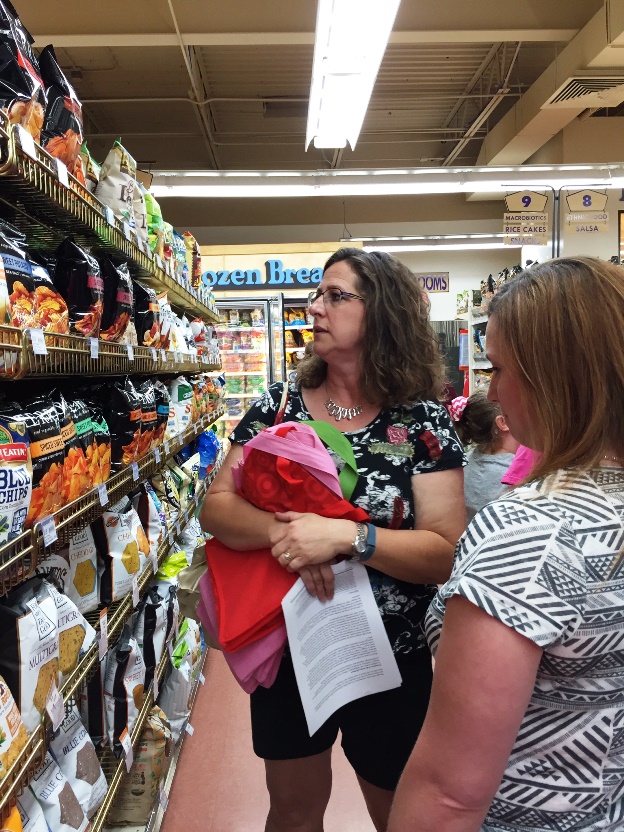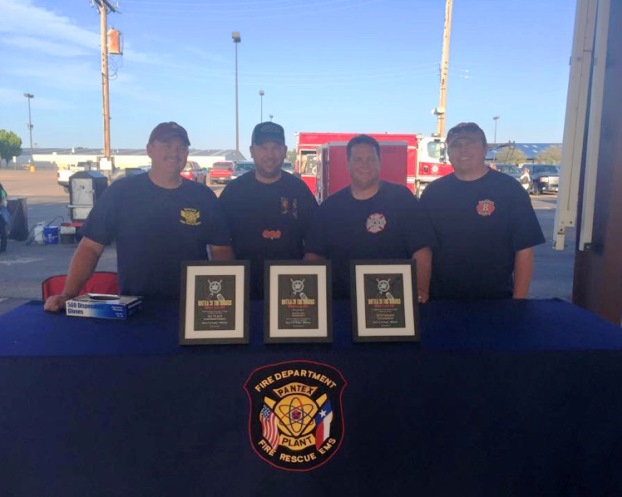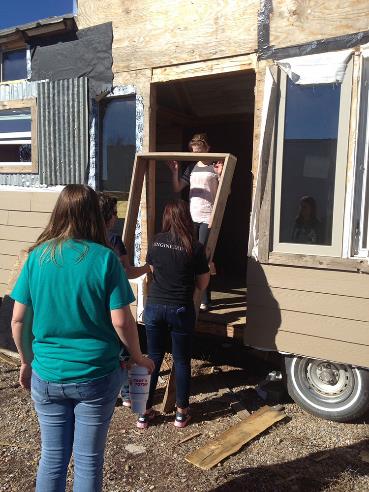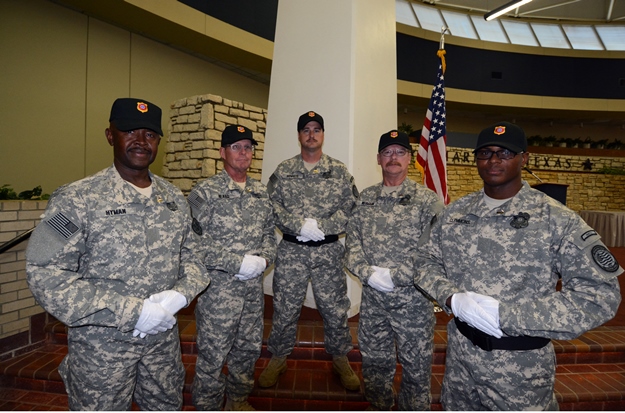Pantex Blog
Education on Aisle Nine

Grocery shopping. Some people carefully plan a weekly menu and painstakingly make a list in an attempt to stick to their budget. Others dread the task so much they just show up at the store hungry, throw items in the cart and go home hoping to make a meal of their basket full of random purchases.
Regardless of which category they fit in, several Pantexans recently turned this mundane weekly task into a fun educational event.
The employees and some family members visited two local grocery stores for healthy shopping tours. The tours, hosted by Market Street United and Natural Grocers, were part of the Active for Life Challenge, a 10-week American Cancer Society program to encourage employees to be more active and eat healthier foods.
At Natural Grocers, the store manager and employees provided an aisle-by-aisle overview of many healthy food products and supplements. They talked about food philosophy and standards. The produce manager even cut a blood orange for participants to taste. Attendees also took home a new product sample and some literature from the store’s nutrition library.
Kelly Delgado-Goudschaal, manager of Pantex Supply Chain Management Transformation and Strategic Initiatives, was impressed by the store’s advice to gradually convert to a healthier lifestyle.
“The store manager encouraged us to make small changes instead of jumping off a cliff into health eating,” Delgado-Goudschaal said. “The prices were also not as expensive as I expected.”
She made the tour a family affair by bringing her wife and three daughters along. The kids said the samples offered during the tour were “not as gross as they expected”.
At Market Street United, a certified dietician offered a two-hour Easy Diabetes Shopping store tour designed to help diabetics make healthier shopping decisions.
Pantex Engineer Sharon Smith said, “The tour was fantastic! We learned how to use the special number on the price stickers to help us choose the healthier items”.
Those who couldn’t attend a store tour were encouraged to complete a grocery store scavenger hunt to learn about product placement and labeling.

Pantex Fire Department wins BBQ Competition

Pantex Fire Department members (left to right) David Stewart, Kyle Butler, Scott Johnson and Jeremy Baker won the 100 Club of the Texas Panhandle’s “Battle of the Badges” barbeque cook-off. The team donated their $1,000 cash prize back to the 100 Club.
The Pantex Fire Department recently participated in the 100 Club of the Texas Panhandle’s annual “Battles of the Badges” barbecue cook-off, a competition between Amarillo area law enforcement and firefighters.
Pantex firefighters won the grand championship for their brisket and placed seventh in
the ribs category. The team received award plaques and a cash prize of $1000, which
they donated back to the 100 Club. The winning team members were Scott Johnson,
battalion chief; David Stewart, captain; Kyle Butler, driver/operator; and Jeremy Baker,
firefighter/paramedic.
The 100 Club provides financial aid for families of public safety personnel who are
seriously injured or killed in the line of duty. In addition, as funds are available, the club
provides law enforcement and firefighting agencies with life-protecting equipment and
educational opportunities that cannot be secured through budgeted funds or agencies. It
serves the 26 Texas Panhandle counties.
A tiny house that STEMs from big hearts

CNS employees are teaching Girl Scouts valuable STEM skills while leading an Amarillo-wide effort to transform an old camper into a tiny home for a woman in need.
Don’t expect a lot of girl talk from Savannah Gates, Rebecca Heinen, Brandy Ramirez and Courtney Waddell. When they get together, they “do.” Naturally, when the Pantex engineers had the opportunity to share what a STEM education is all about with a group of Girl Scouts, they didn’t pull out the trusty (translate “dull”) PowerPoint presentation. They put tools in the girls’ hands and showed them instead.
“I didn’t get into engineering for the sake of engineering,” said Gates, a mechanical engineer who works in Production and Manufacturing Engineering. “I got an engineering degree because it’s the love of what I could do with it in my personal life. I am passionate about using my skills to make my community a better place to live.”
The four Pantexans have worked with local Girl Scout troops on several community improvement projects and engineering‑related activities. To encourage the girls to consider careers in science, technology, engineering and math, or STEM, the engineers involved them in building a “tiny house” to give them hands‑on STEM skills.
Tiny houses are part of a growing trend to lead a simpler, lower‑cost lifestyle, one that many times involves having a reduced ecological impact. Tiny houses are just that — small, usually less than 300 square feet. Some are off‑the‑grid, generating their own electricity, and capture rainwater. They can be portable or attached to slabs. Tiny homes are less expensive to build than larger‑scale homes and are easier and cheaper to maintain.
Gates, Heinen, Ramirez, Waddell and the Girl Scouts are working alongside Pantex carpenters, electricians and welders, who’ve donated their services, as well as city planning officials, community volunteers and businesses, which have contributed supplies, to transform an old camper into a tiny home for a woman in need.
Only 16 percent of American high school seniors are proficient in math and interested in a STEM career. Even among those who do go on to pursue a college major in STEM fields, only about half choose to work in a related career. The U.S. is falling behind internationally, ranking 25th in math and 17th in science among industrialized nations. Source: U.S. Department of Education |
“After hearing about the girls’ efforts from a local news story, our fellow Pantexans began to volunteer their supplies, time and skills to aid in this great cause. This is really an Amarillo‑wide effort spearheaded by Pantex,” said Heinen, who has a degree in industrial engineering. “The house, which is part of a larger community of planned tiny homes, will be for a single mom or woman coming from a poisonous environment, perhaps drug addiction or abuse.”
The Pantexans are teaching the Girl Scouts practical STEM skills through trade work. “We’re breaking away from the traditional STEM classroom approach,” Gates said. “The girls are installing doors and new windows. We’ve put tools in their hands and are showing them how to use them. They’re loving it.”
Imparting their engineering skills isn’t the only motivator for the engineers; they also want to mentor the girls on the importance of giving back to their communities.
“I am always excited to help others,” said Ramirez, a facility engineer in System Engineering. “This project presented a great opportunity to help others as well as teach young girls about engineering and construction. Having a part in building strong, smart, caring young women is very rewarding.”
Waddell, a mechanical engineer, agrees. “The best part of working with my Pantex colleagues is seeing how much love there is for our community,” she said. “The group is constantly looking for ways to give back, and this project is a perfect example of that.”
Pantexans Attend National Honor Guard Academy
Each day, highly-trained first responders proudly don a Pantex firefighter or security police officer (SPO) uniform ready to respond to any potential emergency situations and contribute to the important Pantex mission.

Last October, several of these Pantexans opted for more extensive training with the National Honor Guard Academy class hosted in Amarillo by Potter County Fire and Rescue. Ten members of the Pantex Fire Department (PXFD) Honor Guard and five SPOs graduated from the class after six days of rigorous training.
The Pantexans joined other Amarillo area firefighters and law enforcement personnel in an intense week-long “boot camp” with courses in basic drill and ceremonial movements, flag etiquette, uniform care, casket protocol and even a mock funeral service.
Attending the National Honor Guard Academy training sparked interest in creating a Pantex SPO Honor Guard and provided an opportunity for the PXFD Honor Guard to improve and formalize its already established procedures.
“We started looking for a standardized way to do things like in the military,” said Donovan Morgan, PXFD battalion chief and Honor Guard member. “We wanted to be able to blend into ceremonies with other first responders.”
Members of the PXFD established the Honor Guard in 2011 to show respect and compassion to families of fallen firefighters and law enforcement personnel. They developed their own operations manual, flag and uniform, which Morgan is quick to point out has no rank insignia.
“We might have different ranks in our day-to-day work, but there is no rank in the Honor Guard. We all come together to honor our fallen brother or sister,” Morgan said. “It’s not about us. Our main goal is to show respect to the family.”
The group offers fire service funerals at three response levels based on the nature of the death, and occasionally provides flag and color guard presentations for other official ceremonies.
In addition to supporting Pantex and local area memorial services and official ceremonies, the PXFD Honor Guard also travels on their own time and at their own expense to support services honoring first responders killed in the line-of-duty across the country. They have traveled as far as south as Houston and as far west as Prescott, Arizona. Each September, they even attend a ceremony at the International Association of Fire Fighters Fallen Fire Fighter Memorial in Colorado Springs.
Jody Baker, a Pantex firefighter/paramedic who died in a off-duty vehicle accident December 25, 2011, was very instrumental in organizing the PXFD Honor Guard. After Baker’s death, they were filled with a greater sense of duty and pride.
What began as a way for Pantex firefighters to honor fallen first responders and their families has become a living tribute to one of their own.

Pantex Honors Small Business of the Year

Recently, Pantex partnered up with the West Texas A&M Procurement Center and Small Business Development Center to provide local and regional small businesses with opportunities in the Federal arena at the 2015 Pantex Small Business Symposium.
Rick Palmer, Director of the WTAMU Procurement Center saw this program as a great opportunity to gather all the parties in one room and get down to the business of small business.
“The mission and goal…is to get great local businesses together with potential clients such as governmental agencies and their contractors. We were able to accomplish this by hosting a showcase event where the CNS Pantex managers met many local companies and their people,” Palmer said.
Presentations were made by Pantex, WTAMU, Small Business Administration, the city of Amarillo and its Mayor Paul Harpole, all designed to help walk attendees through the procurement process.
The highlight of the day was a ceremony to recognize the 2015 Pantex Small Business of the Year award, presented by Mayor Harpole and Caleb Pool, representing 13th Congressional District Representative Mac Thornberry’s office.
This year, the award went to Corporate Technology Group (CTG); a locally owned, Woman Owned Small Business, committed to excellence in all phases of business. They provide extraordinary customer service and in FY2014, CTG had a 95.1% overall success rating with Pantex for on-time delivery. CTG met or exceeded Pantex’s goals in almost all instances, negotiated with manufacturers and vendors to lower costs while still meeting required Pantex deadlines.
Monica Graham-Carlson, Pantex Small Business Program Manager, was pleased with the turnout and the commitment made to the small business entrepreneur.
“I think the event was a great success. Pantex is committed to including small businesses in contracting opportunities and believe this event allowed us to reflect on that commitment.”
